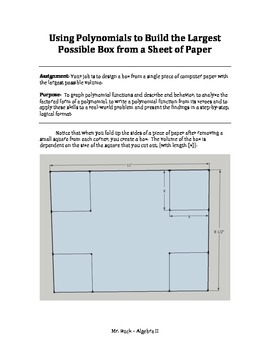Algebra 2 Polynomials Activity and Lab - Using Polynomials STEM Poster Project
Description
This 2-3 day math project gets students thinking about polynomials in the real world. Students design a box from a sheet of paper with the purpose of maximizing the volume and then display the entire mathematical process on a poster. Students add graphs, a model of the box and explain the entire mathematical process in a logical and sequential order.
This project gets students working in groups, discussing ideas and writing about the process they take to solve a problem. Many find the poster project to be an avenue to express their humor and creativity.
A full set of instructions, checklists, guidelines and a grading rubric is included.
The emphasis of this project is not on the 'right answer,' but the process of solving a math problem.





